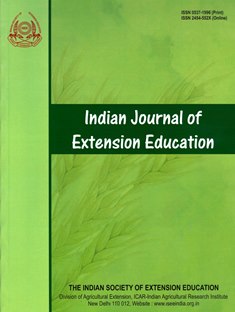Constraints Faced by Pineapple Farmers in Adopting Climate Smart Adaptation Strategies in Kerala
DOI:
https://doi.org/10.48165/IJEE.2025.611RN02Keywords:
Pineapple, Climate smart adaptation, Climate change, ConstraintsAbstract
The demand for pineapples is significant in Kerala, making sustainable cultivation crucial for long-term agricultural development. Ernakulam, Kottayam, and Kollam are among the key pineapple-producing districts in the state. However, pineapple farmers in these regions face numerous challenges in adopting climate-smart adaptation strategies. This study, conducted during May 2024, aimed to identify and prioritize these constraints using data collected from 130 farmers through personal interviews. Garrett’s ranking technique was employed to analyse the data. The findings revealed that market price fluctuations, often caused by reduced fruit weight due to adverse climatic conditions, were the most critical barrier. Other significant constraints included inadequate labour availability, insufficient government support, high input costs, limited agricultural subsidies, restricted access to climate-smart technologies, and inadequate credit facilities. This study emphasizes the need for improved marketing infrastructure, enhanced labour availability, stronger government support, and increased access to climate-smart technologies and financial resources. Addressing these barriers is vital to strengthening the adaptive capacity of pineapple farmers in Kerala and ensuring resilience and sustainability in the face of climate change.
Downloads
References
Baliwada, H., Sharma, J. P., Burman, R. R., Nain, M. S., Kumar, A., & Venkatesh, P. (2017). Constraints and strategies in scaling up of farmer led innovations. Journal of Community Mobilization and Sustainable Development, 12(1), 72-78.
Baruwa, O. I. (2013). Profitability and constraints of pineapple production in Osun state, Nigeria. Journal of Horticultural Research, 21(2), 59–64.
Chandran, V., & Podikunju, B. (2021). Constraints experienced by homestead vegetable growers in Kollam district. Indian Journal of Extension Education, 57(1), 32–37.
Das, L., Nain, M. S., Singh, R., & Burman, R. R. (2014). Constraints in marketing of fruits as perceived by the fruit growers and NERAMAC in Assam. Journal of Community Mobilization and Sustainable Development, 9(2), 114-117.
Das, B., Das, K. K., & Roy, T. N. (2016). Study on marketing system and value addition of pineapple fruit (Ananus comosus) in West Bengal. Agricultural Economics Research Review, 29(2), 279- 285.
Food and Agriculture Organization [FAO]. (2008). Climate change and food security: A framework document. Food and Agriculture Organization of the United Nations.
Garrett, H. E., & Woodworth, R. S. (1969). Statistics in psychology and education (p. 329). Vakils, Feffer, and Simons Pvt. Ltd. Ghazi, N. A. M., Khairuddin, F., & Noor, W. N. W. M. (2023). The factors that influence operation risk on pineapple production: A case study in Muar, Johor. IOP Conference Series: Earth and Environmental Science, 1182, 012027.
Government of Kerala [GoK]. (2022). Agricultural statistics. Department of Economics and Statistics, Government of Kerala. Government of Kerala [GoK]. (2023). Agricultural statistics. Department of Economics and Statistics, Government of Kerala. Intergovernmental Panel on Climate Change [IPCC]. (2001). Climate
change 2001: Synthesis report. Cambridge University Press. Iwuchukwu, J. C., & Udoye, C. E. (2014). Climate change information needs of pineapple farmers in Enugu State, Nigeria. Journal of Agricultural Extension, 18(1), 73.
Joy, P. P. (2013). Pineapple sector in Kerala: Status, opportunities, challenges, and stakeholders. Kerala Agricultural University [KAU].
Kumar, P., Muteshawar, R., Rani, S., Malik, S., & Kumar, N. (2021). Awareness and constraints regarding water conservation practices in Haryana (India). Indian Journal of Extension Education, 57(3), 48–52.
Marie, M., Yirga, F., Haile, M., & Tquabo, F. (2020). Farmers’ choices and factors affecting adoption of climate change adaptation strategies: Evidence from northwestern Ethiopia. Heliyon, 6(4), e03867.
Nancy, L., Bhardwaj, S. K., Mahajan, P. K., Sharma, D. P., & Ravinder, S. (2015). Vulnerability assessment of farming community to environmental changes in low-hills of Himachal Pradesh in India. International Journal of Current Microbiology and Applied Sciences, 4(8), 547–560.
Roy, D. (2015). Identification of technological gap in pineapple cultivation in some selected areas of West Bengal. International Journal of Science, Environment, and Technology, 2(3), 442– 448.
Roy, P., & Ghosh, S. (2022). Constraints faced by pineapple growers in Tripura. Indian Journal of Extension Education, 58(2), 140– 143.
Sharma, A., Kichu, Y., & Chaturvedi, B. K. (n.d.). Economics and constraints of pineapple cultivation in Dimapur district of Nagaland.
Shasani, S., Baneree, P. K., De, H. K., & Panda, S. (2020). Constraints in adoption of groundnut cultivation technology by the farmers of Odisha. Indian Journal of Extension Education, 56(2), 39– 44.
Talanow, K., Topp, E. N., Loos, J., & Martín-López, B. (2021). Farmers’ perceptions of climate change and adaptation strategies in South Africa’s Western Cape. Journal of Rural Studies, 81, 203–219.
Thomas, L., & Dinesh, V. (n.d.). Economics of pineapple cultivation under climate variability in Kerala, India.
Williams, P. A., Larbi, R. T., Yeboah, I., & Frempong, G. K. (2018). Smallholder farmers’ experiences of climate variability and change on pineapple production in Ghana: Examining adaptation strategies for improved production. Journal of Agricultural Extension and Rural Development, 10(2), 35–43.
Published
Issue
Section
License

This work is licensed under a Creative Commons Attribution-NonCommercial-NoDerivatives 4.0 International License.

